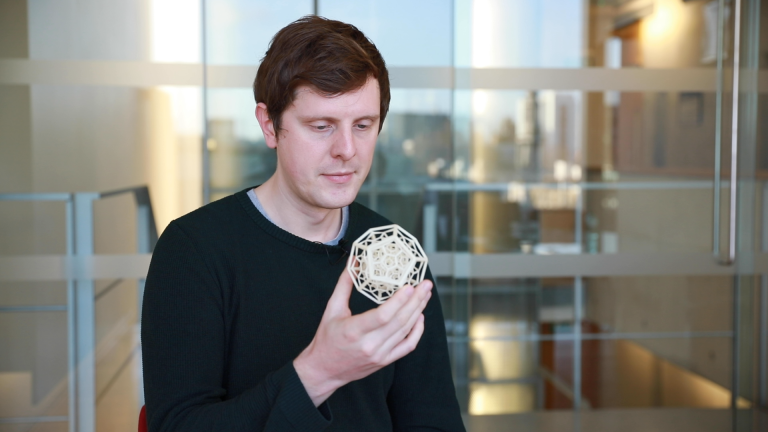Exotic geometry may help make quantum computers robust against noise
12 February 2020
UCLQ research shows that the geometry of hyperbolic 4-manifolds could help simplify error correction.

UCLQ research fellow Nikolas Breuckmann, with Vivien Londe from Institut national de recherche en sciences et technologies du numérique (inria), have in their recent paper detailed how to make quantum computers robust against noise using the geometry of hyperbolic 4-manifolds.
Error correction schemes are essential in quantum computation. Quantum computers are very sensitive and will interact with their environment. This interaction causes noise and can, if uncorrected, make the results of quantum computers useless.
To counter noise, error correction schemes that run on classical computers take measurements of the quantum computer’s qubits and infer what constitutes noise and what operations are needed to counter its effects.
Most current quantum computing architectures use a planar layout of qubits. For example, superconducting qubits like those currently perused by Google and IBM are arranged in 2-D lattices and are kept in dilution fridges at milli-Kelvin temperatures. These architectures may be favourable currently, but the error correction schemes that are based on 2-dimenional layouts of qubits require a lot of classical computation.
Looking beyond 2-D layouts
Breuckmann and Londe’s research into error correction schemes based on exotic geometry builds on an earlier result from two mathematicians, Larry Guth and Alexander Lubotzky, who were interested in testing the limits that had been placed on quantum error correction codes.
Guth and Lubotzky found that if a 4-dimensional hyperbolic geometry was used to arrange spin states they could produce new quantum error correcting codes that broke the bounds of the perceived limits – opening up the possibility to new error correction schemes based on hyperbolic geometries.
““4-D hyperbolic geometry has very nice properties for quantum computing”, said Breuckmann. By making the spins of a quantum computer’s qubits interact as if they were organised in a 4-D hyperbolic geometry we can “harness the power of the geometry and gain a lot more bang for the buck.”
However, Guth and Lubotzky’s work did not detail how to construct such a 4-D hyperbolic geometry. Breuckmann and Londe’s research is the first to detail the construction of a suitable family of 4-D hyperbolic manifolds. Furthermore, Breuckmann and Londe found that error correction schemes are greatly simplified, a major hurdle in previous approaches to quantum error correction.
“Our next step is to see how our error correction scheme performs against current schemes,” said Breuckmann. “We think it is highly competitive and that it can actually outperform currently known schemes, but there are still some tests we need to carry out to ensure it is a fair comparison.”
Planar to modular
So far, all experimental efforts are focused on realizing quantum computers in which the qubits and their interactions are put into a planar layout. The planar layout is really useful when dealing with physical systems in the lab.
However, there are proposals for experiments for quantum computers where their layouts are not planar. For example, there are proposals of modular architectures in which each module holds a small number of qubits. These modules are then linked by using photons sent through optical fibres.
According to Breuckmann, “The flexibility of being able to have qubits interact in such a fashion allows for an exploration of quantum code constructions, opening up researchers to using more exotic geometries.”
PAPER: https://arxiv.org/abs/2001.03568
COMMUNICATIONS CONTACT: Henry Bennie, Communications Manager, UCL Quantum Science and Technology Institute
IMAGE CAPTION: 4-D polytope which tiles hyperbolic 4-space (Credit: N. Breuckmann, UCL)
 Close
Close

